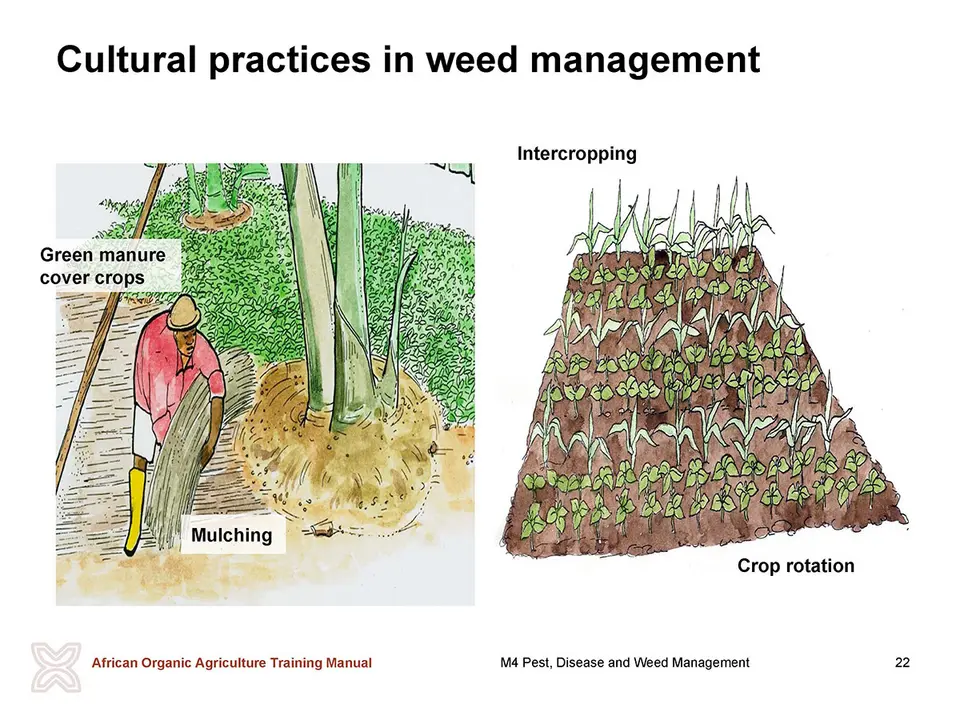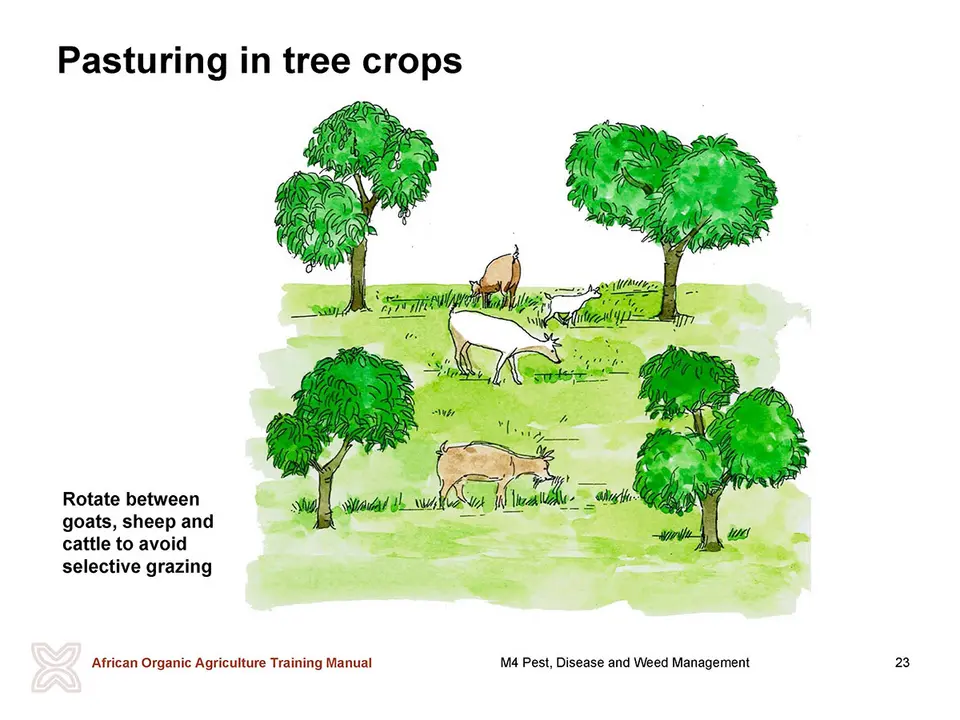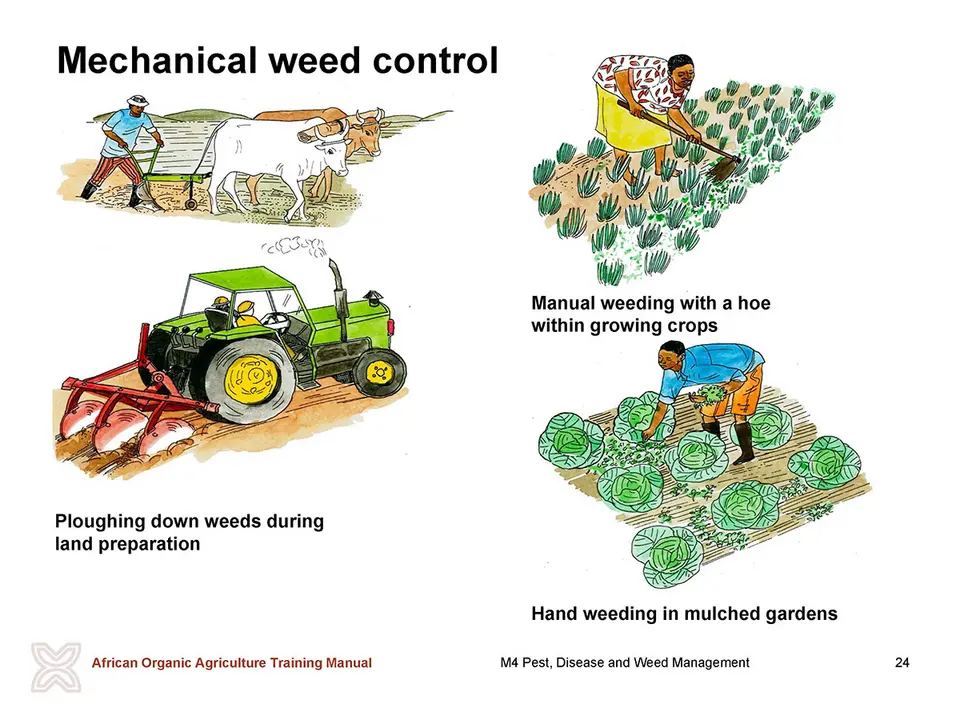Tools to manage weeds
Organic farmers give first priority to prevention of the introduction and multiplication of weeds. The management practices aim at keeping the weed population at a level that does not result in economic loss of the crop cultivation or harm its quality. The goal is not to completely eradicate all weeds, as they also have a role to play on the farm. For example, weeds provide cover that reduces soil erosion. In addition, most of the biological diversity in our crop fields comes from the presence of weeds. They provide habitat for both beneficial biocontrol insects and mycorrhizal fungi. Because weeds offer pollen and nectar they allow biocontrol insects to maintain their populations and, therefore, serve as a valuable instrument in controlling pests.
Discussion on cultural practices for weed management
Share experiences among the participants on how to limit weed problems by cultural practices. Discuss in groups which weed species need special attention, according to the local situation.
Cultural practices to manage weeds (1st step tools)
Tool 1: Weed-free seeds and planting material
Avoiding the introduction of weed seeds into the fields through tools or animals is important. Even more important is to use only weed-free seed and planting material by using either quality seeds/planting material or carefully cleaned seeds.
Tool 2: Choice of crops and varieties
Tall crops and varieties with broader leaves will compete better with late occurring weeds than small varieties with narrow leaves. Some varieties will inhibit and suppress weeds while others will tolerate them. For example, there are witchweed (Striga) resistant maize and cowpea cultivars in many countries of Africa, which give better performance at the same level of weeds where other varieties are more affected.
Tool 3: Crop rotation
The success of rotation systems for weed suppression is based on the use of crop sequences. They create varying patterns of resource competition, allelopathic interference (e.g. root exudates of some plants act like herbicides), soil disturbance and mechanical damage to provide an unstable and frequently unfriendly environment for weeds. Considerable evidence exists that monoculture indeed leads to a less diverse and more intractable weed species than does crop rotation. Growing the same crops in the same site year after year will encourage build up of weed seeds in the soil. This build up of weed seed is referred to as the ‘soil weed seed bank’. Changing the conditions of the crop interrupts the living conditions of the weeds thus inhibiting their growth and multiplication. Some crops efficiently suppress weeds, while others encourage their growth. Crop rotation is thus the most efficient measure to regulate seed and root weeds.
In terms of weed control, crop rotations should include
- alternation of seasonal (spring, summer, autumn and winter or adapted to rain and drought periods) germinating crops.
- alternation of annual and perennial crops (including grass).
- alternation of closed, dense crops which shade out weeds, and open crops which encourage weeds.
- tillage and cutting or topping operations that directly affect the weeds.
Tool 4: Appropriate land preparation
A simple but very effective control tool is to prevent dissemination of weeds is proper land preparation. Land preparation should be timed to eliminate all flowering weeds before setting seeds. A regular scouting for weeds is necessary to limit propagation.
Tool 5: Soil quality management
Proponents of organic farming have long promoted the view that the likelihood of weed problems is reduced with the establishment and maintenance of ‘healthy’ soil. The enhancement of soil fertility plays an important role in weed control. Especially the organic matter and the microbial activity associated with organically managed soils provide a buffering capability to maintain optimal nutrient and mineral balance in crop plants. However, due to fertilization, weed seeds germinate rapidly altogether. They can then be eliminated in one round of weeding. Soil fertility can be improved by:
- Applying compost and farm manure - Besides improving organic matter content and serving as slow-release fertilizer, compost can help control weeds if applied as a soil cover to eliminate light to soil surface. Weed seeds will then stay dormant. However, compost must be of best quality and should not contain weed seeds.
- Applying organic mulches - Mulches eliminate light to soil surfaces. Many small seeded weed species require light at and near the surface of the soil to trigger a break in their otherwise dormant nature. Dry, hardy material, that decomposes slowly, keeps its effect longer than fresh mulch materials which decompose very fast.
Tool 6: Appropriate sowing time and density
Optimum growing conditions enhance the optimum crop plant development and their ability to compete against weeds. Proper crop spacing will ensure that minimum space is available for the growth of weeds and will minimize competition with weeds. This will effectively restrict weed development. In order to apply this approach, the limiting weeds must be known and the seasons in which they occur. A weed calendar of the area or region, if available, might be of help. It will be used to manage weeds in a targeted fashion with proper timing and effect.
Habitat management in weed control (2nd step tools)
Tool 7: Intercropping (mixed cropping and under-sowing)
Although intercrops are not always better than monocrops in weed suppression, in some cases they can be very effective if well planned. Intercropping with fast-growing weed-suppressive species (‘smoother crop’ or ‘living mulch’) between rows of main crop species is effective in weed control. There are different examples known to work in Africa, for example, sowing cowpeas and egusi melons or pumpkins as intercrops in cassava to reduce weed occurrence.
Undersowing or cover cropping aims to cover the ground with a quick-growing, dense layer of vegetation underneath the crop. The undersown species is usually leguminous, which improves soil fertility on top of suppressing weeds.
Tool 8: Pasturing
In perennial crops like coffee, mangoes, avocadoes or cocoa, the use of sheep and goats to reduce rampant weed growth is becoming common. In case of cattle, broadleaf weeds tend to predominate due to the cattle preference for grasses. Therefore, it is necessary to rotate with sheep and goats which prefer broadleaves to overcome this selective grazing.
Direct control measures for weed management (3rd step tools)
Tool 9: Mechanical weed control
Mechanical weed control is the most common and effective method of direct weed control. It can be used for the initial land preparation but also during the later stages of the crop growth. When weeds are found to be fully grown with deep roots, then they can only be controlled through mechanical weed control methods.
Mechanical weed control may involve weeding the whole crop or it may be limited to selective inter-row or intra-row weeding. Manual weeding is probably the most important mechanical control measure. As it is very labour intensive, reducing weed density as much as possible in the field will bring less work later on. There are different tools to dig, cut and uprooting the weeds; hand, ox-drawn and tractor-drawn tools. Using the right tool can increase work efficiency significantly. Whichever tool is used, weeding should be done before the weeds flower and produce seeds. The weather and soil conditions under which the operation is carried out will have a major influence on its efficacy (e.g. mechanical weeding is less effective when soils are wet during or after weeding operations).
Tool 10: Biological control of weeds
The soil-borne fungus Fusarium oxysporum (different isolates from Burkina Faso, Mali and Niger) is very effective in reducing the witch weed (Striga hermonthica and S. asiatica) in different cereal crops, leading to yield increases in scientific trials. Other Fusarium species found in Sudan and Ghana are very effective, too (Fusarium nygamai, F. oxysporum and F. solani). This mycoherbicide is on the way to being formulated and registered in different countries in Africa.
Rhizobacteria capable of suppressing germination of witch weed (Striga spp.) seeds or actually destroying the seeds are particularly promising biological control agents since they can be easily and cheaply formulated into seed inoculants. Pseudomonas fluorescens putida isolates significantly inhibited germination of Striga hermonthica seeds. However, currently no biocontrol product is available.
Tool 11: Thermal weed control
Flame weeding by heating briefly to 100° C and higher is also another mechanical way of controlling weeds. This provokes coagulation of the proteins in the leaves and the bursting of cell walls. Consequently, the weeds dry out and die. Although it is an effective method, it consumes a large amount of fuel (gas) and needs machinery and is, therefore, expensive. Due to this, it is rarely used in Africa.
Discussion on direct control of weeds
Share experiences among farmers on how to limit weed problems by direct control measures. Discuss in groups the methods that are the most effective for the predominant weed species.



 tap and then scroll down to the Add to Home Screen command.
tap and then scroll down to the Add to Home Screen command.